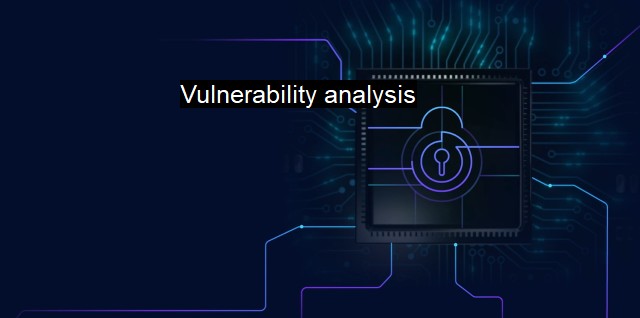What are Vulnerability analysis?
Enhancing Cybersecurity with Vulnerability Analysis: Processes and Importance Explained
Vulnerability analysis, with is a systematic process used to identify, classify and prioritize vulnerabilities in computer systems, applications, networks and other information systems. Vulnerability analysis is a fundamental aspect in maintaining the security of computer systems, especially in heavily networked environments that include firewall protection, antivirus programs, and intrusion detection systems.Vulnerability analysis involves understanding and evaluating vulnerabilities in the context of threats and potential impacts they can have on various system assets. In this context, a vulnerability represents a weakness in a system that can be exploited by attackers to perform unauthorized actions within a computer system. To exploit a vulnerability, an attacker must have at least one applicable tool or technique that can connect to a system weakness. In this sense, vulnerability analysis is the process of defining, identifying, classifying and prioritizing these weaknesses.
This analysis participates in crucial tasks in maintaining an optimum level of security, providing ways to discover security vulnerabilities with a sense of criticality, track and manage system loopholes, and eventually strengthen system security. Regardless of the organizational presence, whether it's a small company or a multinational, everyone has something valuable that an attacker targets. This valuable possession could range from sensitive data, financial information, personal records, or even intangible classified information.
The process begins with an in-depth system analysis where each configuration, point of access, or potential opening for intrusion is identified and checked. This can be done both manually and through automated software or a combination of both, known as hybrid vulnerability analysis. This process entails scanning the systems for known vulnerabilities like system flaws, viruses, malware, bugs, and backdoors. Not only does this apply to the computer's primary operating system, but also to the applications loaded onto the computer.
Next, this process involves verifying that current cybersecurity measures are effective. This includes intrusion detection systems, firewalls, antivirus applications, and other protective measures. The system's security setup is monitored to see how quickly it alerts about a possible breach or intrusion attempt, or whether it recognizes it at all.
The context and relevance of the vulnerability are then evaluated by using threat modeling. This step considers every potential threat that could exploit each vulnerability, how it would affect the system, and what the potential damage could be. This helps to prioritize vulnerabilities in terms of severity, which guides further responses and preventive measures.
Organizations then seek to eliminate these vulnerabilities. Antivirus software, form an integral part of combating these weaknesses. They act as a guarding force, designed to detect, prevent, and act against the intrusion of malicious software into the computer system. Antivirus software updated frequently can protect against new vulnerabilities identified.
Once vulnerabilities have been prioritized, the remediation phase begins, where vulnerabilities are resolved – from patching software to changing configurations, strengthening encryption, or fully rebuilding a compromised system. users and IT staff need to be aware of common tactics employed by cyber attackers, so concerted efforts to tackle vulnerabilities from the root can be implemented effectively.
Vulnerability analysis, in conjunction with strong antivirus software, plays a critical role in overall network security. Frequently checking for any system vulnerabilities is necessary as technology advances, and unknown threats arise. We can never be confident that there will be no intrusion or attack on our systems, but we can certainly work to make our technical environments as secure as possible. In the end, the purpose of vulnerability analysis is to provide an organization or individual with knowledge about their weaknesses before an attacker becomes aware of them. This enables us to protect our systems and data proactively - anticipation is always better than recuperation!

Vulnerability analysis FAQs
What is vulnerability analysis in cybersecurity?
Vulnerability analysis is a process of identifying, evaluating and prioritizing weaknesses or vulnerabilities in a system, network or application that could be exploited by a cyber attacker. It is an essential component of cybersecurity to ensure that there are no blind spots in the system that could be exploited for malicious purposes.What are the benefits of conducting vulnerability analyses?
Conducting vulnerability analyses allows organizations to: 1. Identify weaknesses in their network or system before attackers can exploit them. 2. Prioritize and allocate resources for patching vulnerabilities. 3. Reduce the risk of a successful attack or data breach. 4. Maintain compliance with relevant security standards and regulations.What is the difference between vulnerability analysis and antivirus software?
Vulnerability analysis and antivirus software serve different but complementary purposes. Antivirus software is designed to detect and remove known malicious software from a system, while vulnerability analysis looks for potential vulnerabilities in a system that could be exploited by attackers. In other words, antivirus software deals with known threats, while vulnerability analysis tries to identify and prevent unknown or future threats.How often should vulnerability analyses be conducted?
The frequency of vulnerability analyses depends on the complexity of the system or network and the level of risk involved. In general, vulnerability analyses should be conducted regularly or after any major changes to the system or network. Most organizations conduct vulnerability analyses quarterly, annually or after a significant security event.| | A | | | B | | | C | | | D | | | E | | | F | | | G | | | H | | | I | | | J | | | K | | | L | | | M | |
| | N | | | O | | | P | | | Q | | | R | | | S | | | T | | | U | | | V | | | W | | | X | | | Y | | | Z | |
| | 1 | | | 2 | | | 3 | | | 4 | | | 7 | | | 8 | | |||||||